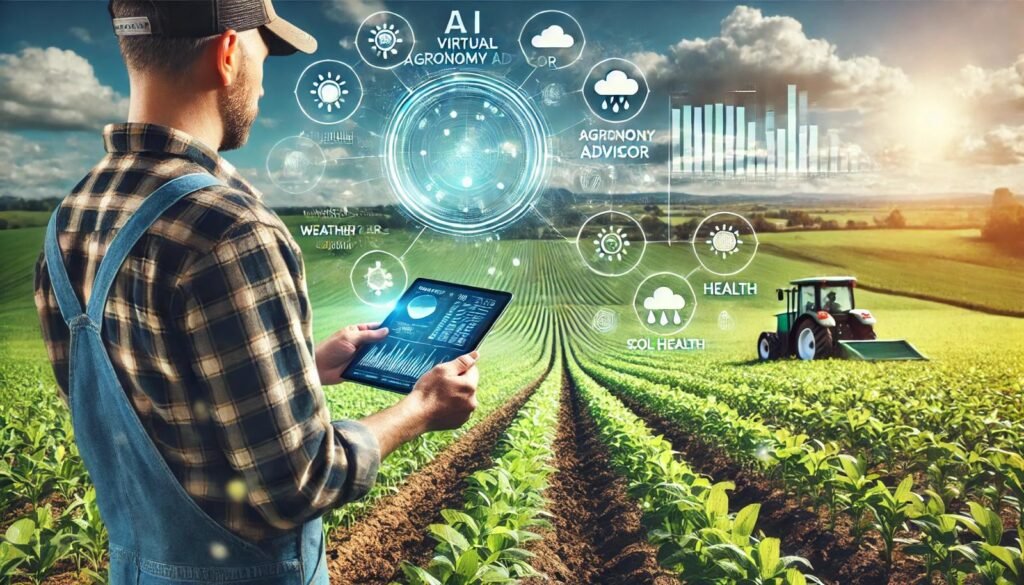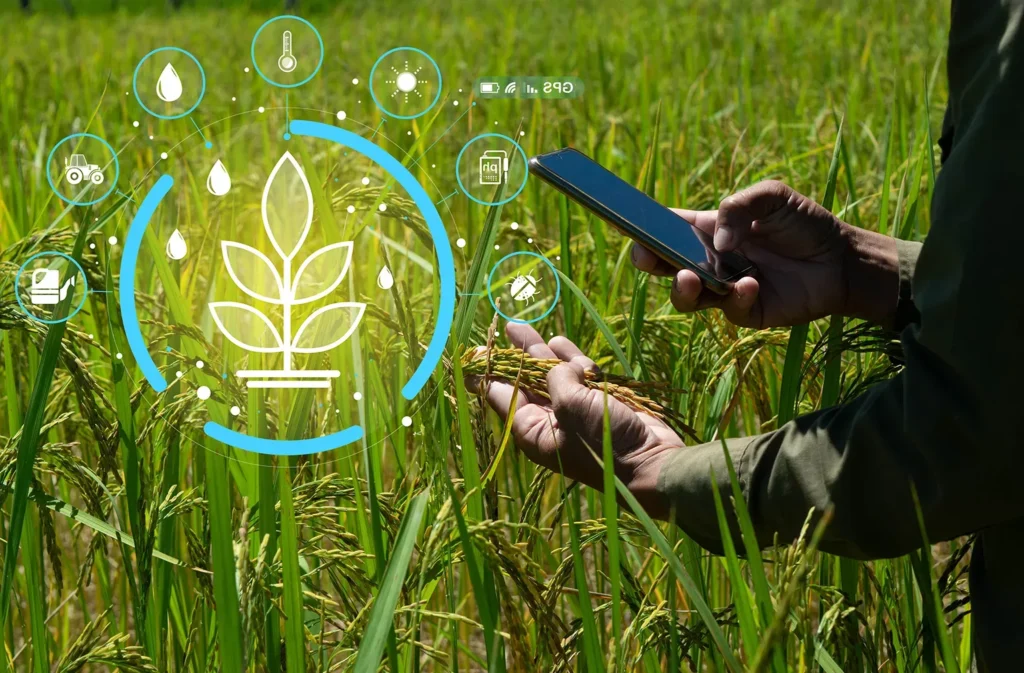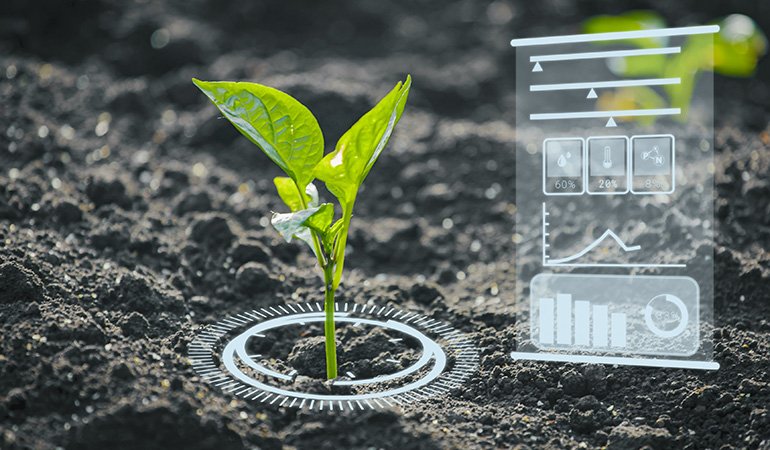L'agriculture de précision a révolutionné l'agriculture à grande échelle. Satellites, drones, capteurs intelligents et algorithmes d'IA complexes aident les grandes exploitations à maximiser leurs rendements et à minimiser le gaspillage. Mais qu'en est-il des petits agriculteurs, ceux qui exploitent moins de deux hectares, souvent avec des budgets limités et un accès limité aux outils de haute technologie ?
Jusqu'à récemment, les avantages des technologies agricoles semblaient inaccessibles aux micro-agriculteurs. La situation est en train de changer. Grâce aux progrès rapides des technologies agricoles, intelligence artificielle (IA) et une nouvelle vague d’outils agro-technologiques abordables, L’agriculture IA n’est plus réservée aux méga fermes.
In this article, we’ll break down ce que signifie réellement l'agriculture IA, explore how it’s pertinent et accessible aux petits agriculteurs, et mettre en évidence des outils pratiques et peu coûteux cela peut faire une grande différence dans votre rendement, vos revenus et votre durabilité.
Qu'est-ce que l'agriculture IA ? Aperçu rapide
Agriculture par IA, également connue sous le nom de agriculture intelligente ou l'agriculture de précision alimentée par l'intelligence artificielle—utilise l’apprentissage automatique, la reconnaissance d’images et des algorithmes prédictifs pour prendre des décisions agricoles fondées sur les données.
Au lieu de se fier à des suppositions, les agriculteurs peuvent désormais utiliser des outils d’IA pour :
- Prédire les changements météorologiques avec une grande précision
- Détecter précocement les maladies des cultures grâce aux caméras des smartphones
- Automatiser l'irrigation en fonction des données du sol en temps réel
- Recevez des conseils agricoles personnalisés via des chatbots
Et la meilleure partie ? Vous n’avez pas besoin d’un diplôme en informatique ni d’un budget énorme. Bon nombre de ces outils sont désormais conçus en pensant aux petits exploitants.
Pourquoi l'IA est importante pour les petits agriculteurs

Voici cinq raisons pour lesquelles l’IA devient essentielle, même pour les petites exploitations agricoles :
1. De meilleures décisions avec moins de conjectures
L'IA analyse de vastes quantités de données (météo, sol, santé des cultures) pour formuler des recommandations. Cela signifie moins d'erreurs et un meilleur timing pour les semis, la fertilisation et la récolte.
2. Détection des maladies et des ravageurs
La détection précoce est essentielle. Grâce aux applications de reconnaissance d'images basées sur l'IA, vous pouvez détecter les infections avant qu'elles ne se propagent, sauvant ainsi des récoltes entières.
3. Économies d'eau et de ressources
Smart irrigation systems powered by AI can reduce water usage by 20–40% by delivering water only when and where it’s needed.
4. Augmenter les rendements et les revenus
De petites améliorations dans la prise de décision peuvent engendrer de grands gains. Les outils d'IA aident les petits agriculteurs à devenir plus compétitifs et résilients.
5. Accès facile aux conseils d'experts
Grâce aux assistants virtuels basés sur l’IA, les agriculteurs peuvent poser des questions dans leur langue locale et obtenir des réponses instantanées et pertinentes sans avoir besoin d’un consultant.
Idées fausses courantes sur l'IA dans l'agriculture
Clarifions quelques mythes :
- ❌ “AI is too expensive.”
✔ Many tools are free or cost under $10/month. Some work offline or via SMS. - ❌ “It’s only for tech-savvy farmers.”
✔ New apps are designed for ease of use—no need for advanced training. - ❌ “Small farms are too simple for AI.”
✔ On the contrary, small farms can see the biggest benefits because they’re more sensitive to small improvements in yield and resource use.
Types d'outils d'IA que les petits agriculteurs peuvent utiliser

Examinons maintenant les catégories d’outils d’IA qui aident déjà les micro-agriculteurs du monde entier.
1. Outils de prévision météorologique IA
Comprendre les microclimats est essentiel pour les petites parcelles. Les applications météo basées sur l'IA utilisent des données hyperlocales pour fournir des prévisions adaptées à votre localisation exacte.
✅ Popular Tools:
- Tomorrow.io (anciennement ClimaCell) : Propose des prévisions basées sur l'IA basées sur plusieurs flux de données, notamment des satellites et des capteurs IoT.
- IBM Weather AI via l'application The Weather Channel : Fournit des informations prédictives sur la pluie, le gel et les périodes de plantation optimales.
- WeFarm (spécifique à l'Afrique) : Service par SMS fournissant des conseils météorologiques et agricoles.
💡Use Case:
Un producteur de tomates dans une zone rurale du Kenya utilise Tomorrow.io pour éviter l'irrigation pendant les jours de pluie, économisant ainsi de l'eau et améliorant le rendement.
2. Détection des maladies des cultures grâce à l'IA
Des applications pour smartphones avec reconnaissance d'images permettent aux agriculteurs de diagnostiquer les maladies des plantes en prenant une photo. L'IA la compare à des milliers d'images de plantes et recommande des traitements.
✅ Popular Tools:
- Plantix : Couvre plus de 30 cultures et plus de 500 maladies ; fonctionne hors ligne.
- AgriDoc (Asie du Sud-Est) : Utilise des bibliothèques de cultures localisées pour identifier les problèmes.
- Google Lens (Basique) : Identifie les maladies grâce aux retours d’information de la communauté.
💡Use Case:
Aux Philippines, un agriculteur utilise Plantix pour diagnostiquer la pyriculariose du riz à un stade précoce. Un traitement rapide permet d'éviter des pertes de récolte d'une valeur de $200.
3. Drones IA abordables pour les petites exploitations agricoles
Pas besoin de dépenser 10 000 £ pour un drone agricole. Les modèles d'entrée de gamme à moins de 500 £ offrent désormais la cartographie, la pulvérisation et l'analyse des cultures en temps réel.
✅ Popular Tools:
- DJI Mini 2 SE : Drone économique avec GPS, capture d'images et capacités de relevé aérien.
- Taranis AI + tout drone compatible : Offre une cartographie des maladies et une détection des mauvaises herbes.
- XAG R150 (robot agricole compact) : Autonome et intégré à l'IA pour les petites parcelles.
💡Use Case:
Une ferme de 2 acres au Brésil utilise un DJI Mini 2 pour créer des cartes aériennes et suivre la santé des cultures, augmentant ainsi le rendement de 18%.
4. Chatbots et assistants agricoles virtuels
Les chatbots IA agissent comme des agronomes numériques, répondant aux questions, diagnostiquant les problèmes et donnant des conseils en temps réel.
✅ Popular Tools:
- Bot d'IA numérique vert : Conseiller virtuel basé sur WhatsApp pour les agriculteurs indiens.
- Intégration ChatGPT + SMS : Les développeurs locaux créent des robots de questions-réponses IA pour l'agriculture.
- Bonjour Tractor AI Assistant : Conseille les petits agriculteurs sur la location et la planification des machines.
💡Use Case:
Un agriculteur rural en Inde utilise un chatbot WhatsApp pour obtenir des recommandations d’engrais en fonction de l’état actuel du sol, et ce gratuitement.
5. Irrigation intelligente avec IA
Ces systèmes surveillent l’humidité du sol et la météo pour contrôler efficacement l’utilisation de l’eau.
✅ Popular Tools:
- NetBeat par Netafim : Système d'irrigation goutte à goutte alimenté par l'IA avec alertes mobiles.
- Marc arable 2 : Combine des capteurs et de l'IA pour l'irrigation et le suivi météorologique.
- PlantVillage Nuru (assistant IA hors ligne) : Aide à la planification des programmes d’irrigation et de la rotation des cultures.
💡Use Case:
In Uganda, a smallholder uses Arable’s recommendations to reduce water use by 30% during dry seasons.
6. Analyse agricole basée sur l'IA
Ces outils fournissent des informations exploitables à partir de données agricoles simples, aidant les agriculteurs à mieux planifier.
✅ Popular Tools:
- Journaux de la ferme : Suivi du rendement, du sol, des intrants et des extrants avec des prédictions d'IA intégrées.
- Akilimo (Nigéria) : Outil d'IA pour les producteurs de manioc offrant des prévisions de rendement et une planification des engrais.
- CropIn : Télédétection et analyse IA pour les petites et moyennes exploitations agricoles.
💡Use Case:
Un producteur de manioc utilise Akilimo pour programmer les applications d'engrais, augmentant ainsi sa production de 25%.
Avantages de l'adoption de l'IA : l'avantage des petites exploitations agricoles

| Avantage | Comment cela aide les petites exploitations agricoles |
|---|---|
| Détection précoce des problèmes | Réponse plus rapide aux maladies/parasites |
| Efficacité des ressources | Réduit le gaspillage d'eau et d'engrais |
| Rendements accrus | De petites améliorations conduisent à un grand retour sur investissement |
| Réduction du travail | Automatise des tâches telles que la pulvérisation ou la planification |
| Une meilleure planification | Des décisions basées sur les données tout au long de la saison |
Les défis et comment les surmonter
Bien que l’IA ait du potentiel, elle présente certains défis communs :
❗ Challenge: Internet Connectivity
Solution: Utilisez des applications compatibles hors ligne (par exemple, Plantix, Nuru) et des services d'IA basés sur SMS.
❗ Challenge: Cost of Devices
Solution: Commencez avec des smartphones à bas prix ou partagez des appareils au sein de coopératives.
❗ Challenge: Lack of Training
Solution: Les ONG et les services de vulgarisation proposent de plus en plus de formations pratiques et de vidéos dans les langues locales.
Comment démarrer avec l'agriculture IA
Il n'est pas nécessaire d'adopter tous les outils du jour au lendemain. Commencez petit et développez votre boîte à outils progressivement :
- Choisissez un problème à résoudre en premier : Est-ce la météo ? L'eau ? La maladie ?
- Choisissez un outil gratuit ou à faible coût : Essayez Plantix, Tomorrow.io ou FarmLogs.
- Rejoignez un groupe agricole local : Découvrez comment d’autres utilisent les outils d’IA dans votre région.
- Partager les connaissances : Formez d’autres petits agriculteurs de votre région et contribuez à renforcer la résilience locale.
Conclusion : l’IA n’est pas l’avenir, elle est déjà là
AI farming isn’t about replacing the farmer—it’s about donner aux petits exploitants des outils qui étaient autrefois hors de portée. Que vous cultiviez des légumes sur une parcelle derrière votre maison ou que vous gériez une ferme biologique de plusieurs acres, l'agriculture intelligente est faite pour vous.
Commencez avec un outil d'IA. Apprenez-le. Appliquez-le. Partagez-le. Voyez votre rendement, vos revenus et votre confiance augmenter.
✅ Prêt à adopter une approche intelligente dans votre petite ferme ?
📥 Download our free PDF: “Top 5 AI Tools for Small Farmers in 2025”
📬 Subscribe to our newsletter for monthly tips on affordable AI tools.
🔗 Prochainement dans la série : Prédire la pluie : les meilleures applications météo d'IA pour les petits agriculteurs →


